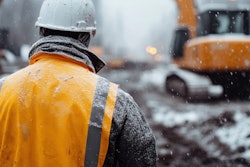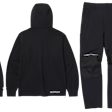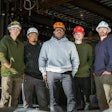
A construction worker’s apparel choices in what may be harsh winter weather conditions will make the difference in comfort, safety, and job performance.
OSHA notes on its winter weather website that dressing properly is extremely important to preventing cold stress.
Workers can protect themselves from cold stress by wearing at least three layers of loose-fitting clothing, the agency notes.
Layering provides better insulation. OSHA recommends:
- An inner layer of wool, silk or synthetic (polypropylene) to keep moisture away from the body. Thermal wear, wool, silk or polypropylene, inner layers of clothing that will hold more body heat than cotton.
- A middle layer of wool or synthetic to provide insulation even when wet.
- An outer wind and rain protection layer that allows some ventilation to prevent overheating.
- Avoid tight clothing as it reduces blood circulation, and warm blood needs to be circulated to the extremities. Wear an insulated coat or jacket that is water-resistant if necessary.
- A knit mask to cover face and mouth (if needed).
- A hat that will cover the ears. A hat helps keep the whole body warmer by reducing the amount of body heat that escapes from the head.
- Insulated gloves (water resistant if necessary) to protect the hands.
- Insulated and waterproof boots to protect the feet.
This IRONPROS story delves into the proper eyewear to have on hand to prevent snow blindness.
According to the Cleveland Clinic, snow blindness is a form of photokeratitis, a temporary, painful eye damage from exposure to ultraviolet (UV) light such as sunlight or reflected sunlight that can occur when snow and ice reflect UV rays.
Snow and ice can lead to intense glare, especially in sunny conditions on the work site. Snow’s reflective nature increases the amount of light entering the eyes, a driving factor to discomfort and damage.
It also can occur from a welder’s flash and other sources.
Options abound in the market for winter workwear. One brand that offers construction apparel for extreme cold conditions is RefrigiWear.
The new RefrigiWear HiVis PolarForce Jacket, offering protection down to -40°F and over 500 gram insulation. The jacket features a water-repellent, wind-tight shell and adjustable cuffs and an inner drawcord. Performance-Flex technology at the elbows allows full range of motion without losing insulation. Grip Assist on the sleeves provides a secure grip, even in subzero conditions. Multiple pockets offer convenient storage. Hi-visibility yellow with orange piping ensures visibility in low light.
Another option: RefrigiWear HiVis PolarForce Bib Overalls, which offers similar features, plus a YKK zipper, storm flap, and reinforcement patches.
The company also offers a contrasting high-visibility orange version of the PolarForce Sweatshirt.
Another brand focused on winter wear is STUDSON which recently released accessories designed to better protect workers from the effects of cold temperatures and working in dark and loud environments.
Recent releases include a fleece skull cap, a telescoping headlamp, and an earplug garage attachment, all purpose-built for use with the STUDSON SHK-1 series of ANSI Z89.1 Type II safety helmets.
According to ANSI Z89.1-1969, accessories and winter liners must be specifically designed to be compatible with the helmet’s protective properties. The company notes beanies and hoodies should not be used for cold weather protection under a safety helmet. It offers an alternative: the STUDSON Fleece Helmet Liner, designed to fit snugly under any version of the SHK-1 safety helmet.
STUDSON CEO Ryan Barnes notes: “Outdoor workers exposed to cold and windy conditions are at risk of cold stress, and they require effective clothing accessories that will enable them to stay comfortable, safe, and productive.
“Providing warm headwear specifically designed for the SHK-1 safety helmet enables workers to mitigate the effects of cold stress without sacrificing the effectiveness of their safety helmet. For example, wearing a hood under a safety helmet may keep a worker warm, but it can reduce the effectiveness of a safety helmet during a slip, trip, or fall.”
While the weather is getting colder, it is still important to stay hydrated.
OSHA advises workers to stay dry and pack extra clothes; moisture can increase heat loss from the body. Take breaks throughout the day in warm, dry areas to prevent health issues.
Consult the jobsite’s safety manager to ensure apparel choices meet safety standards.














